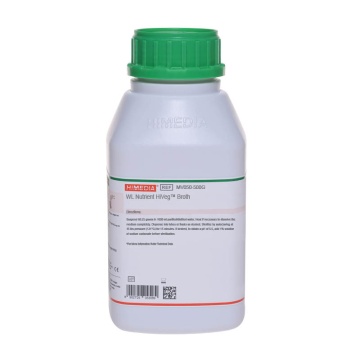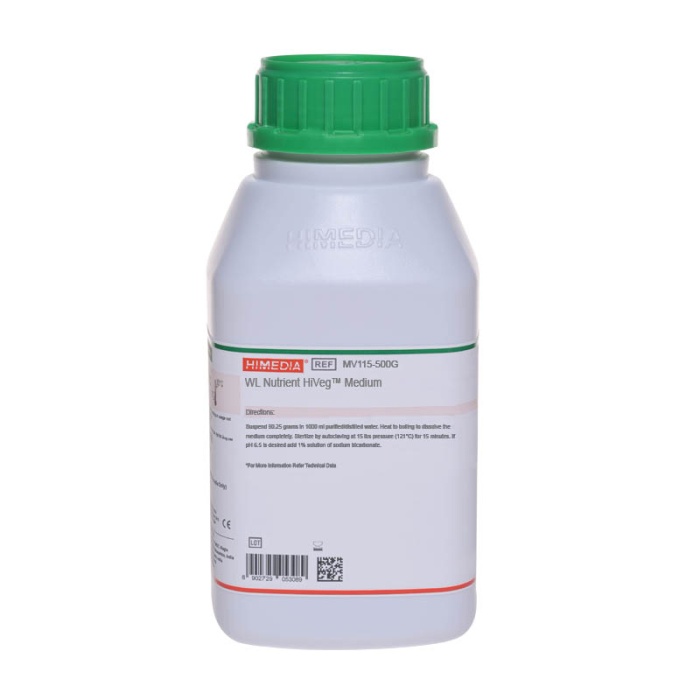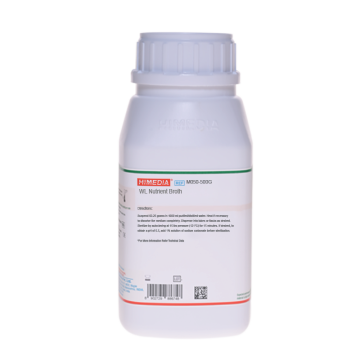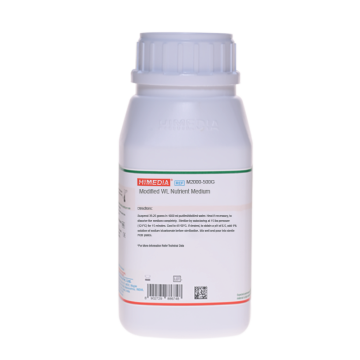 Your enquiry has been submitted
Your enquiry has been submitted
WL Nutrient Medium
Intended Use
Recommended for cultivation and isolation of microorganisms encountered in brewing and industrial fermentation processes.
Composition**
| Ingredients | Gms / Litre |
|---|---|
| Tryptone | 5.000 |
| Yeast extract | 4.000 |
| Dextrose (Glucose) | 50.000 |
| Potassium dihydrogen phosphate | 0.550 |
| Potassium chloride | 0.425 |
| Calcium chloride anhydrous | 0.125 |
| Magnesium sulphate | 0.125 |
| Ferric chloride | 0.0025 |
| Manganese sulphate | 0.0025 |
| Bromo cresol green | 0.022 |
| Agar | 20.000 |
Final pH (at 25°C): 5.5±0.2
**Formula adjusted, standardized to suit performance parameters
Directions
Suspend 80.25 grams in 1000 ml purified / distilled water. Heat to boiling to dissolve the medium completely. Sterilize by autoclaving at 15 lbs pressure (121°C) for 15 minutes. If desired, to obtain a pH of 6.5, add 1% solution of sodium bicarbonate before sterilization. Cool to 45-50°C. Mix well and pour into sterile Petri plates.
Principle And Interpretation
WL (Wallerstein Laboratory) media are formulated as described by Green and Gray for the examination of materials encountered in brewing and for industrial fermentations containing mixed flora of yeast and bacteria (1, 2). Bakers yeast counts can be carried out in this medium at a pH 5.5. By adjusting the pH to 6.5, the medium can be used for obtaining counts of Baker and distillers yeast (5).
WL Nutrient and WL Differential Media are used in combination. One plate of WL Nutrient Agar and two plates of WL Differential Agar are prepared (5). The WL Nutrient Agar plate is incubated aerobically to give a total yeast count while one WL Differential Agar plate gives the count of acetic acid bacteria, Flavobacterium, Proteus and thermophilic bacterial count when incubated aerobically. The other WL Differential Agar Plate is incubated anaerobically for the growth of lactic acid bacteria and Pediococcus. While determining microbial counts using these media, temperature and time of incubation will vary depending on the nature of material under test. Temperatures of 25°C are employed for brewing materials while 30°C are employed for baker's yeast and alcohol fermentation mash analyses.
Yeast extract which serves as a source of trace elements, vitamins and amino acids. Tryptone is used as a source of nitrogen, amino acids and carbon. Dextrose is the source of carbohydrate. Buffering of the medium is done by potassium dihydrogen phosphate. Potassium chloride, calcium chloride and ferric chloride are essential ions that help to maintain the osmotic balance. Magnesium sulphate and manganese sulphate are sources of divalent cations. Bromo cresol green is a pH indicator.
Type of specimen
Brewing sample
Specimen Collection and Handling
For Brewing samples, follow appropriate techniques for sample collection, processing as per guidelines and local standards. (1,2).
After use, contaminated materials must be sterilized by autoclaving before discarding.
Warning and Precautions
Read the label before opening the container. Wear protective gloves/protective clothing/eye protection/ face protection. Follow good microbiological lab practices while handling specimens and culture. Standard precautions as per established guidelines should be followed while handling specimens. Safety guidelines may be referred in individual safety data sheets.
Limitations
- While determining microbial counts using these media, temperature and time of incubation will vary depending on the nature of material under test.
- Temperatures of 25°C are employed for brewing materials while 30°C are employed for baker's yeast and alcohol fermentation mash analyses.
Performance and Evaluation
Performance of the medium is expected when used as per the direction on the label within the expiry period when stored at recommended temperature.
Quality Control
Appearance Light yellow to light green homogeneous free flowing powder
Gelling Firm, comparable with 2.0% Agar gel.
Colour and Clarity of prepared medium Bluish green coloured very slightly opalescent gel forms in Petri plates.
Reaction Reaction of 8.02% w/v aqueous solution at 25°C. pH : 5.5±0.2
pH 5.30-5.70
Cultural Response Cultural characteristics observed after an incubation at 25-30°C for 40-48 hours.
| Organism | Inoculum (CFU) | Growth | Recovery |
|---|---|---|---|
| Escherichia coli ATCC 25922 (00013*) | 50-100 | fair-good | 40-50% |
| Lactobacillus fermentum ATCC 9338 | 50-100 | fair-good | 40-50% |
| Proteus mirabilis ATCC 25933 | 50-100 | fair-good | 40-50% |
| Saccharomyces cerevisiae ATCC 9763 (00058*) | 50-100 | good-luxuriant | >=70% |
| Saccharomyces uvarum ATCC 28098 | 50-100 | good-luxuriant | >=70% |
Key: (*) Corresponding WDCM numbers.
Storage and Shelf Life
Store between 10-30°C in a tightly closed container and the prepared medium at 20-30°C. Use before expiry date on the label. On opening, product should be properly stored dry, after tightly capping the bottle in order to prevent lump formation due to the hygroscopic nature of the product. Improper storage of the product may lead to lump formation. Store in dry ventilated area protected from extremes of temperature and sources of ignition. Seal the container tightly after use. Use before expiry date on the label.
Product performance is best if used within stated expiry period.
Disposal
User must ensure safe disposal by autoclaving and/or incineration of used or unusable preparations of this product. Follow established laboratory procedures in disposing of infectious materials and material that comes into contact with clinical sample must be decontaminated and disposed of in accordance with current laboratory techniques (3,4).
Reference
- Green S. R. and Gray P. P., 1950, Wallerstein Lab. Commun., 12:43
- Green S. R. and Gray P. P., 1950, Wallerstein Lab. Commun., 13:357
- Isenberg, H.D. Clinical Microbiology Procedures Handbook 2nd Edition.
- Jorgensen, J.H., Pfaller, M.A., Carroll, K.C., Funke, G., Landry, M.L., Richter, S.S and Warnock., D.W. (2015) Manual of Clinical Microbiology, 11th Edition. Vol. 1.
- MacFaddin J. F., 1985, Media for Isolation- Cultivation- Identification- Maintenance of Medical Bacteria, Vol.1, Williams & Wilkins, Baltimore, Md.
Revision: 03/2019
| Product Name | WL Nutrient Medium |
|---|---|
| SKU | M115 |
| Product Type | Regular |
| Physical Form | Powder |
| Origin | Animal |
| Packaging type | HDPE |
| References | 1. Green S. R. and Gray P. P., 1950, Wallerstein Lab. Commun., 12:43 2.Green S. R. and Gray P. P., 1950, Wallerstein Lab. Commun., 13:357 3.MacFaddin J. F., 1985, Media for Isolation- Cultivation- Identification- Maintenance of Medical Bacteria, Vol.1,Williams & Wilkins, Baltimore, Md. |
| Customized Product Available | No |












